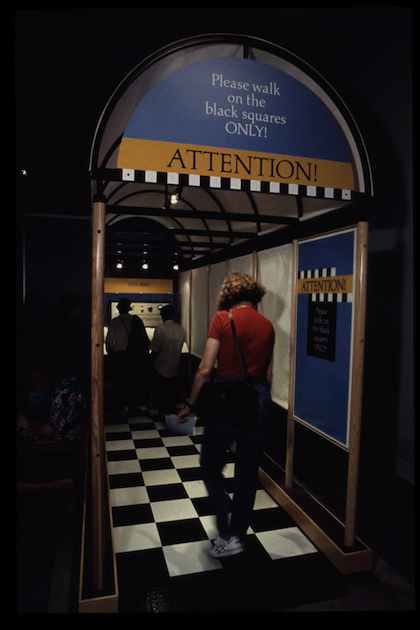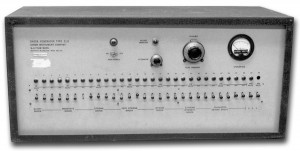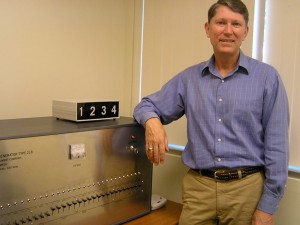If you look at the photo you’ll notice a sign above the woman who’s entering an exhibit at the American Psychological Association’s 100th anniversary exhibition. You’ll see it reads “Please walk on the black squares ONLY.
According to exhibition curator Caryl Marsh, 9 out of 10 people at the exhibit hopscotched to the end of the black and white chequerboard walkway.
Look closely at the photo. Can you see what was waiting for them at the end of the walkway? Yep, you guessed it, Stanley Milgram’s shock machine. Alongside the machine was an explanation of how it had been used by Milgram as a way of measuring our propensity to follow orders.
While people still debate whether Milgram did in fact measure obedience to authority there’s no doubt that his machine still has the capacity to draw a crowd. It was the most visited exhibit in the APA’s touring exhibition.
It was Milgram’s students who came up with an early prototype of the shock machine based on their teacher’s rough drawing.
Although Milgram later loaned this early prototype to a nun who was planning an obedience study of her own, this was unusual. Milgram was intensely proprietary about his experiment. He was infuriated when psychologist Arnold Buss published a book about aggression that featured a shock machine. Milgram was convinced that Buss had copied his idea.
Milgram lavished both time and money on the design and construction of what he called his ‘crucial measuring instrument’. After testing the machine and making improvements to the design, Milgram bought the necessary components and electronic parts from Radio Shack for $261.86 and had the machine made up in Yale’s electronic and mechanical shops.
The outer metal cabinet was built by G.E. Wheeler Company and Hermes Engravers of New York engraved the front panel. Ronald (Edwin) Salmon spent 86 hours assembling and soldering and the machine was finished on July 19, 1961. The total cost of the shock machine, including parts and labour, was $374.
Jerry Burger who in 2006 conducted his own version of Milgram’s obedience experiment for American TV, said that when he saw Milgram’s machine he knew he’d have to make something more modern-looking. To Burger, Milgram’s machine looked “like something out of Frankenstein’s lab”. Burger and the ABC team decided that their version needed to look modern while remaining as close as possible to the original.
The outside of both machines are similar – the switches are in the same place, the dimensions are the same, and the words used to describe the levels of shock are identical. But inside, Berger’s is much more sophisticated, with a computer that synchronises the switches pressed with the learner’s protests and cries.
Milgram’s machine doesn’t travel much anymore. But you can see it at the Archives of the History of American Psychology where it’s on display. And where it’s a drawcard for visitors who make the journey to Akron specifically to see the machine that made Milgram famous.






2 Comments
‘A nun planning an obedience study’? She could have popped her head into Sister Bernadette’s Prep class at Our Lady’s Primary in Geelong in 1965 and found plenty of children being very obedient. Whenever Sister Bernadette said she was ‘ very cross with the class’ I looked up at Jesus on the cross, above the blackboard, and reminded myself to be very obedient.
Hey there, I think your blog might be havinng browser compatibility issues.
When I look att your website inn Safari, it looks fine but wwhen opening in Internet Explorer, it has some overlapping.
I just wanted to give you a quick heads up! Other thedn that, terrific blog!